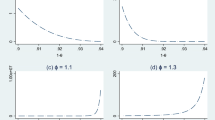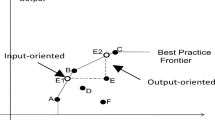Abstract
This paper examines an international Cournot duopoly wherein a home firm and a foreign firm compete in the home market under exchange rate uncertainty. The foreign exporting firm, being risk averse, has incentives to hedge its exchange rate risk exposure. In a two-stage setting, we show that hedging via an unbiased currency futures market acts as a strategic device. In particular, under either constant or decreasing absolute risk aversion, an increase in the hedging volume of the foreign firm promotes its exports and deters the home firm’s output. In contrast to the well-known full-hedging result in a perfectly competitive environment, we find that the foreign firm over-hedges for strategic reasons. Furthermore, the separation result from the hedging literature under perfect competition no longer holds in our duopoly framework, i.e., equilibrium output levels depend on the risk attitude of the foreign firm as well as the probability distribution of the spot exchange rate.

Similar content being viewed by others
Notes
Our model applies equally well to a broader case that the foreign firm competes in a world market where the home currency is the standard invoice currency. We thank an anonymous referee for pointing this out.
Throughout the paper, a tilde (~) signifies a random variable.
In a setting of two-way trade in both countries, the risk preferences of the home and foreign firms become crucial because both firms are now exposed to the exchange rate risk. Our results may not be robust to this symmetric scenario.
For any two random variables, \(\tilde{X}\) and \(\tilde{Y}\), we have \({\rm Cov}(\tilde{X},\tilde{Y})={\rm E}(\tilde{X}\tilde{Y}) -{\rm E}(\tilde{X}){\rm E}(\tilde{X})\).
This outcome is observationally equivalent to the benchmark equilibrium considered in Section 3.
References
Allaz B (1992) Oligopoly, uncertainty and strategic forward transactions. Int J Ind Organ 10:297–308
Allaz B, Vila JL (1993) Cournot competition, forward markets and efficiency. J Econ Theory 59:1–16
Benninga S, Eldor R, Zilcha I (1985) Optimal international hedging in commodity and currency forward markets. J Int Money Finance 4:537–552
Brander JA, Spencer BJ (1985) Export subsidies and international market share rivalry. J Int Econ 18:83–100
Broll U, Wahl JE, Zilcha I (1995) Indirect hedging of exchange rate risk. J Int Money Finance 14:667–678
Broll U, Wong KP (2006) Multinationals, hedging, and capital structure under exchange rate uncertainty. Open Econ Rev 17:103–114
Broll U, Wong KP, Zilcha I (1999) Multiple currencies and hedging. Economica 66:421–432
Broll U, Zilcha I (1992) Exchange rate uncertainty, futures markets and the multinational firm. Eur Econ Rev 36:815–826
Bulow JI, Geanakoplos JD, Klemperer PD (1985) Multimarket oligopoly: strategic substitutes and complements. J Polit Econ 93:488–511
Collie D (1992) International trade and Cournot equilibrium: existence, uniqueness and comparative statics. Bull Econ Res 44:55–66
Dornbusch R (1987a) Exchange rates and prices. Am Econ Rev 77:93–106
Dornbusch R (1987b) Exchange rates economics. Econ J 97:1–18
Friberg R (1998) In which currency should exporters set their prices? J Int Econ 45:59–76
Hahn FH (1962) The stability of the Cournot oligopoly solution. Rev Econ Stud 29:329–331
Hens T (1997) Exchange rates and perfect competition. J Econ 65:151–161
Hughes JS, Kao JL (1997) Strategic forward contracting and observability. Int J Ind Organ 16:121–133
Kirman A, Phlips L (1996) Exchange rate pass-through and market structure. J Econ 64:129–154
Nain A (2006) Corporate risk management in an industry setting: an empirical investigation. Working paper, McGill University
Schelling T (1960) The strategy of conflict. Harvard University Press, Cambridge, MA
Selten R (1975) Reexamination of the perfectness concept for equilibrium points in extensive games. Int J Game Theory 4:25–55
Wong KP (2003a) Currency hedging with options and futures. Eur Econ Rev 47:833–839
Wong KP (2003b) Export flexibility and currency hedging. Int Econ Rev 44:1295–1312
Wong KP (2006) Foreign direct investment and forward hedging. J Mul Finance Manage 16:459–474
Wong KP, Chow KW (1997) Endogenous sequencing in strategic trade policy game under uncertainty. Open Econ Rev 8:353–369
Acknowledgements
We would like to thank George Tavlas (the editor) and an anonymous referee for their helpful comments and suggestions. The usual disclaimer applies.
Author information
Authors and Affiliations
Corresponding author
Rights and permissions
About this article
Cite this article
Broll, U., Welzel, P. & Wong, K.P. Export and Strategic Currency Hedging. Open Econ Rev 20, 717–732 (2009). https://doi.org/10.1007/s11079-008-9080-x
Received:
Accepted:
Published:
Issue Date:
DOI: https://doi.org/10.1007/s11079-008-9080-x




